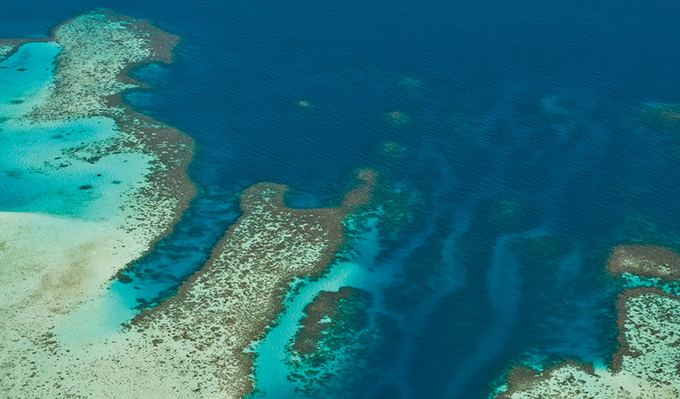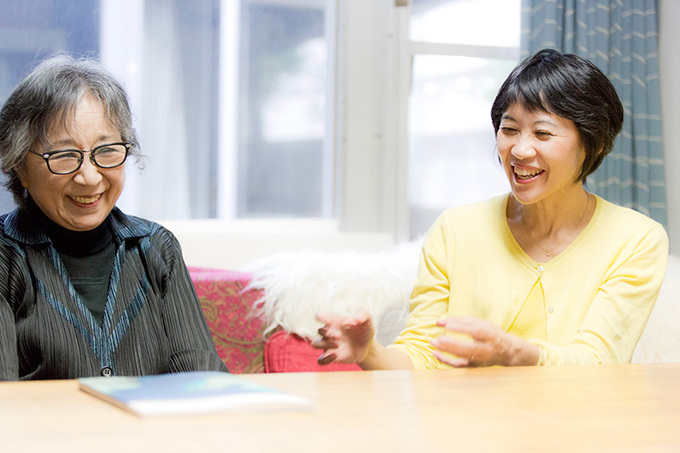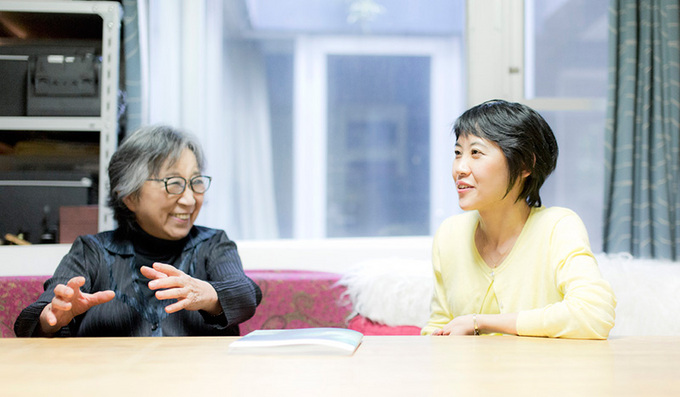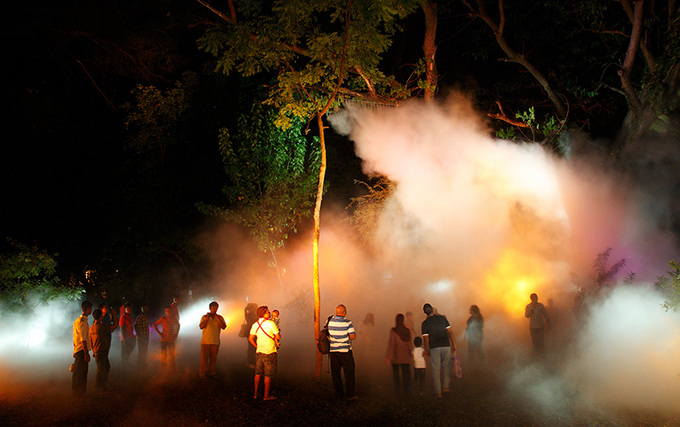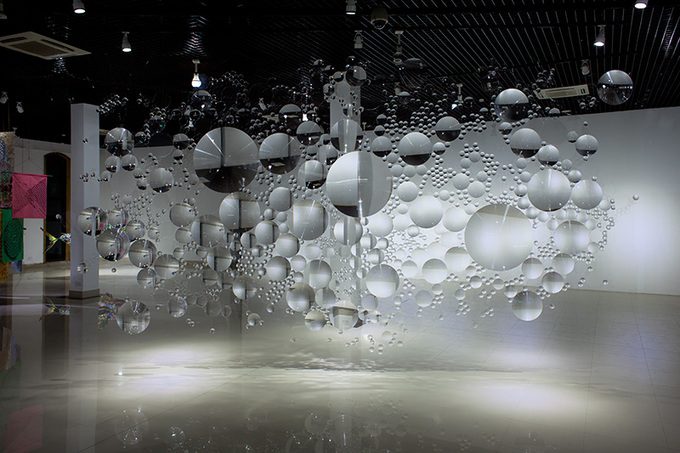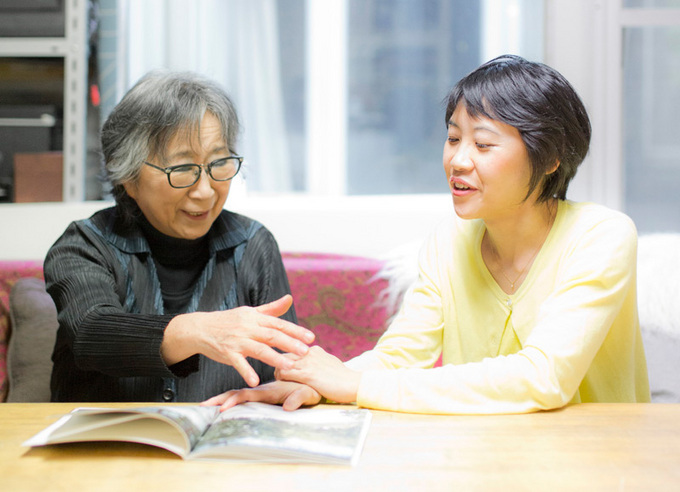Breathing Atolls: Japan-Maldives Contemporary Art Exhibition
Fujiko Nakaya, Artist
Sachiko Namba, Curator
An exhibition with full of first-ever
----"Breathing Atolls" was the first exhibition of contemporary art in the Maldives. Tell us about the events leading up to the opening.
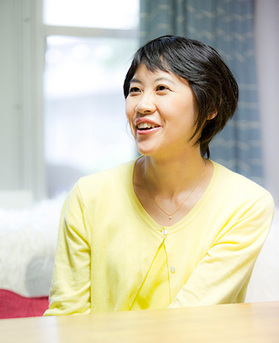 NAMBA: The Maldives is an atoll nation where half the land reaches only a meter above sea level. The islands are in danger of submersion due to global warming. In light of this threat, the Ambassador of the Republic of Maldives to Japan, residing in Tokyo, approached the Japan Foundation with the idea of organizing an exhibition around the themes of environmental preservation and cultural exchange between the two nations.
NAMBA: The Maldives is an atoll nation where half the land reaches only a meter above sea level. The islands are in danger of submersion due to global warming. In light of this threat, the Ambassador of the Republic of Maldives to Japan, residing in Tokyo, approached the Japan Foundation with the idea of organizing an exhibition around the themes of environmental preservation and cultural exchange between the two nations.
The ambassador might have had in mind a simple showcase of photographs of the ocean. But this was the first-ever suggestion of a full-scale exhibition of contemporary art in the Maldives, and also the first opportunity to introduce Japanese artists in the islands. The talks were so full of first-ever that they inspired the Japan Foundation to assemble a proper team and take on a bigger challenge. So they asked me to curate the show.
I went to the Maldives for the first time in September last year. I visited the venue, the National Art Gallery of Maldives, where I met the local curator, Mariyam Fazeela Abdul-Samad, a number of Maldivian artists, and some people from an environmental organization. We discussed the direction of the show.
We decided that the Japanese artists should spend some time in the Maldives, and in their own way do their research and create new works for the exhibition. We would also invite Maldivian artists to participate, in the interest of promoting cultural exchange. The point was not for the artists from Japan to fly in, drop off their work, and then go sightseeing. The process of creation was important. We wanted their work to reflect the natural environment of the Maldives and their interaction with the locals.
----Yukihiro Taguchi, Yodogawa-Technique... All these artists are known for producing their work on-site.
NAMBA: Yes, and I wanted to introduce as wide a variety of Japanese artists as possible, from those who work with two-dimensional art to those who handle installations, video, and themes related to the environment. Because a homecoming exhibition in Tokyo was confirmed afterward, I also invited two Malivian artists: Afzal Shaafiu Hasan, aka "Afu," a sand animation and performance artist, and Ali Nishan, aka "Millzero," a photographer who documents the culture of the Maldives.
As for the content, it was important for the show to represent not so much conceptual art but visual, interactive, easy-to-understand art. After all, it would be a shame if the Maldivians got confused and lost interest in contemporary art with their very first exhibition.
In presenting the culture of one country or region to another, it's always difficult to make an unbiased selection of artists. This has been a topic of debate since the 1990s.
NAKAYA: It was a good idea to have the artists go to the Maldives in person and produce their work on-site. I asked Fazeela, the curator, whether she had ever displayed contemporary art before. She said the gallery had introduced two foreign artists in the past, but neither of them visited the islands. Whereas this time, all the artists came over. I think that was the best part of the project.
NAMBA: All the artists came over--that was exciting, yes. It was also an inspiration that you, Ms. Nakaya, came once last December, before the show in March. You helped to build communication between the artists.
NAKAYA: We were like one big family.
NAMBA: You created a wonderful cozy feeling. Everyone had fun. For my part, I started out by "teaching" the staff of the National Art Gallery what kind of support an installation artist needs. As I said, the project was full of first-ever. I'm quite sure that artists coming in everyday and asking where they could find this, or where they could buy that, was a brand new experience for them. But despite all the trouble that might have surfaced in terms of communication, the Maldivian staff members did a great job.
NAKAYA: Fazeela said she learned a lot about curating from you, Ms. Namba.
NAMBA: Well, Fazeela is only in her 20s. When I first met her in September, she had been at the gallery less than six months.
NAKAYA: All the same, I think you helped to build her confidence. At first she seemed overwhelmed and afraid to even touch the artwork. But in the end she asked me whether she could be in charge of maintaining my exhibit, and it was my turn to be surprised.
NAMBA: You have a point. The breakdown after the exhibition was unbelievably smooth compared to the untidiness of the setup. Fazeela had all the tools ready and everything. I saw her removing your exhibit from the tree, and she was doing a brilliant job. I was quite proud, actually.
The cornerstone of Nakaya's work
NAKAYA: Did you know Fazeela called me "the shaman"?
NAMBA: Correction. I believe she called you "master shaman."
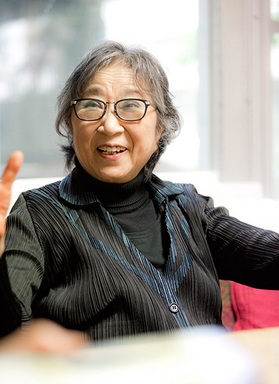 NAKAYA: Wind is an essential element of my fog sculptures, you see. I always collect data and search for a spot where the breeze gives just the right amount of movement to the fog.
NAKAYA: Wind is an essential element of my fog sculptures, you see. I always collect data and search for a spot where the breeze gives just the right amount of movement to the fog.
The space at this venue, though, was the Sultan Park adjacent to the gallery. Wherever I went within it, I had to work with the local climate. So instead of collecting data, I thought it best to simply feel the breeze myself. So I wandered the park, going around and around in circles. I was trying to get a feel of the breeze, of course, but to Fazeela, it might have looked like I was connecting with the spiritual world. Besides, fog was a new experience for the Maldivians.
NAMBA: The country is situated on the equator. The year-round temperature averages 30ºC.
NAKAYA: The environment simply doesn't produce fog. So everyone was amazed. One of the Japanese artists, Terunobu Fujimori, told me the children were trying to catch the fog in their hats.
----Were they hoping to take a piece home as a souvenir?
NAKAYA: My impression was, they were literally "grasping at fog." In any event, this fog was really a brand new experience for the Maldivians. And the people's reaction to it, in turn, gave us visitors a glimpse of the Maldivian climate, the environment, the people's history. The children's trying to catch the fog in their hats, as if they were catching butterflies, proves that they respond to new experiences keenly.
----They have fresh sensibilities.
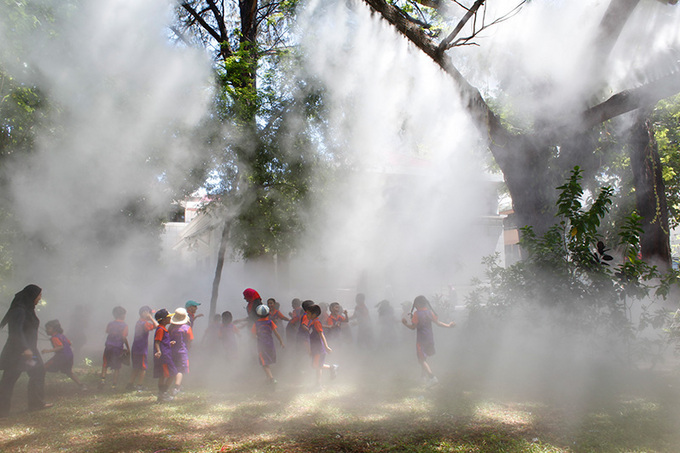
Fujiko Nakaya's fog sculpture popular with the children
NAKAYA: I've never thought of my work as art, you know. I come from the anti-art generation.
I'm happiest when my work makes others happy. I love meeting new people, and watching them experience my fog and open up their sensibilities and express that in one way or another. In that sense, I was moved by the people of the Maldives more deeply than they were by the fog.
----Wasn't it you, Ms. Namba, who wanted to display Ms. Nakaya' fog sculpture in the Maldives?
NAMBA: Yes, it was. The environment was a big theme of this exhibition. But I had reservations about art being used as a form of propaganda. I wanted to justify the connection between the theme and the medium, give the Maldivian people a reason to think about the environment through art. And I'm happy to say I did this, thanks to Ms. Nakaya, who approaches art with a scientist's perspective.
I expected her to be very busy. And the schedule was tight. The exhibition was confirmed in September, the research visit was planned for December, and the show was to start in March. When I asked her if she would participate, I was nervous the whole time that she might say she didn't have the time. When in reality...
NAKAYA: I said I'd love to!
NAMBA: She readily agreed.
NAKAYA: I said nothing would make me happier than a trip to the Maldives.
----Was it your first trip there?
NAKAYA: Oh yes, my very first visit. The sky and the waters stretching across the atoll, a life of harmony with the ocean, the refreshing sea breeze... Everything about the trip was wonderful. It was too bad I didn't go snorkeling. But otherwise, I thoroughly savored the untamed nature.
Like Ms. Namba, I also disapprove of hackneyed attitudes toward the environment.
Japan's utilities are saying they're running short of electricity so let's all save power. It's propaganda. Whether with electricity or water, it's foolish to "save" so we can all have our small share of the pie. That's like denying ourselves of life as we know it.
The solution is to get more creative in our involvement with the environment. Nature will always give back more than we put into it. It isn't nature that lacks anything. It's us humans that lack imagination.
You often hear of being gentle to the environment. That's exactly the kind of approach that severs our involvement with nature. Say you take your children out to the fields but forbid them to pick the flowers. You're essentially robbing them of the experience of nature.
NAMBA: Right. Your children would wilt.
NAKAYA: Society at large tends to ban contact with nature. But my work is all about getting in touch with and interacting with nature. Offering a way to do that, you could say, is my art.
NAMBA: The fog you create, though artificial, is generated from real water. You don't use the common fog machine.
NAKAYA: I'm not interested in fog as a special effect. People grow tired of the effects. The first time is OK. But after that, it becomes hackneyed.
I'm more interested in creating settings where people can think about the environment and correspond with nature. In fact, I had made only a few fog sculptures until the Foggy Forest at Showa Kinen Park in Tokyo was completed in 1992.
NAMBA: What made you start working with fog again in recent years?
NAKAYA: When I closed the Video Gallery SCAN in Tokyo in 2008, I fancied taking up art as a hobby in my old age.
Joking aside, around that time, Fumio Nanjo asked whether I'd be interested in showing at the Singapore Biennale, which he was directing. Also around the same time, Tsutomu Mizusawa asked whether I'd like to show at the Yokohama Triennale, which he was directing.
NAMBA: Your work at Sankeien Garden in the Yokohama Triennale was amazing.
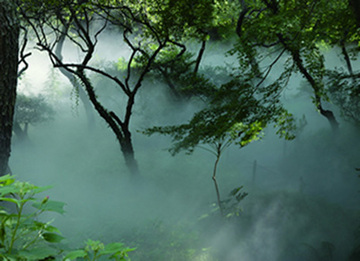
Tales of Ugetsu, 2008, Fujiko Nakaya
Photo: Fujiko Nakaya
NAKAYA: The setting was around the old Tokeiji Temple, in the outer garden. I chose the location for its complex breeze. The trees and the topography created a soft turbulence, which mixed well with the downward current from the cliff in the background.
As I said before, I count on the wind to give just the right amount of movement to the fog. The breeze is essential in breathing life into my sculptures. If I have to work in a space with only a monotone breeze, sometimes I even sculpt the landscape, maybe even plant trees, to create a desirable turbulence.
----You are widely known as a fog sculptor, Ms. Nakaya. But perhaps few people realize that the act of sculpting, in your case, includes selecting settings and even creating landscapes.
NAKAYA: I call that aspect of my work "negative sculpting." That is, in my work, the atmosphere is a mold in which the weather changes every minute and shapes the fog in a different way. By modifying the environment, I'm actually lending nature a helping hand, so that it can give shape to the fog.
NAMBA: The lighting also changes every time, doesn't it?
NAKAYA: Actually, that's the movement of the fog changing how the sunlight reflects on objects in the setting. The fog conceals or obscures things that were visible only moments ago. The fog makes even the sun's rays speak in an eloquent way.
----How did the people of the Maldives react to all this?
NAMBA: They adored it. The children were dancing away in the fog.

Children dancing in Nakaya's fog sculpture
NAKAYA: My work seems to be a hit with children and dogs. When I showed in Australia, the dogs kept running in and out of the fog. I suppose it's a welcome relief from the arid climate.
NAMBA: In the Maldives, I was looking forward to seeing how you would use the tremendously open space of the Sultan Park. I certainly didn't expect the fog to extend over such a wide area.
NAKAYA: At first I envisioned the fog streaming down from the trees like a waterfall and the clouds coming down on the ground. But then I also wanted the visitors to immerse themselves in the fog, and feel the mist on their skin. So I ended up adding a few nozzles on the ground.
NAMBA: I had heard from Fazeela that the park usually didn't attract too many people. So I was a bit relieved that Ms. Nakaya's work created a buzz and drew a big crowd to the park everyday. The fog and light performance on the night of the opening was initially planned as a one-time event. But so many people requested an encore that we held it on the closing day as well.
Art created through ties with the people and the location
----Were the people of the Maldives taken by surprise by their very first exhibition of contemporary art? Did they expect it to offer anything as extraordinary as fog?
NAMBA: They didn't expect fog in the park, and they definitely didn't expect live birds in the gallery!
----By live birds, you mean the artwork by Tetsuro Kano. Mr. Kano uses everything from daily sundries to plants, as well as birds, and creates his own ecosystem. Did he use native birds this time?
NAMBA: He used the myna bird from the Maldives. The children loved his exhibit, too. The National Art Gallery pours a good deal of energy into educational programs, so the students from local elementary schools were regular visitors. But never did they expect to find live birds inside the gallery. They were very surprised.

Exhibit by Tetsuro Kano (left), Myna bird from the Maldives (right)
NAKAYA: Yodogawa-Technique's fish sculpture was popular with the adult visitors, when they realized it was made with the garbage that they had tossed out. And Yukihiro Taguchi--the artist himself--was a hit with all the locals.

Exhibit by Yodogawa-Technique (left), Yodogawa-Technique collecting garbage (right)
NAMBA: Mr. Taguchi spent a total two months in the Maldives--the longest time of any of the visiting artists. He uses the frottage technique, where he rubs all sorts of textured surfaces throughout the town, from street signs to gate signs. These "rubbings" become the artwork, and they strike a chord of recognition in the visitors. Everyone knew some part of his exhibit by sight, whether it was an elementary school emblem or a street sign. And I think they liked that these familiar motifs could be an ingredient in art.
The Maldives' capital, Malé is a small island, and during his visit Mr. Taguchi got to know all its streets by heart. The residents spotted him "rubbing" signs in every nook and cranny. He was quite the talk of the town. As a matter of fact, Mr. Taguchi deserves all the credit for the good number of local volunteers who helped with the exhibition. He discovered them all.
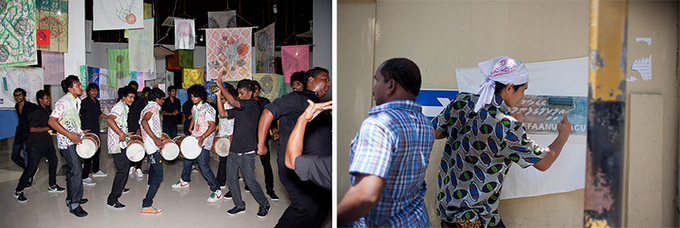
Exhibit by Yukihiro Taguchi (left), Taguchi employing the frottage technique (right)
NAMBA: (Continued) Terunobu Fujimori built a small cottage using local materials. But because the tradition of using palm leaves for thatching is dying out on the island of Malé, he recruited craftsmen from other islands of the Maldives and worked with them.
Many exhibits in this show were born through collaboration with the local people. Only in the Maldives can evokes images of the ties between people.

Exhibit by Terunobu Fujimori (left), Fujimori collaborating with local craftsmen (right)
NAKAYA: The engineers from the "garage" were also very helpful. They're in charge of maintaining the vehicles and machinery at the official residence of the President.
NAMBA: The President's residence is just a stone's throw away from the National Art Gallery. So we borrowed all sorts of equipment from this "garage." I might say our exhibition was endowed with the all-out support of the President himself.
NAKAYA: And all these engineers were very professional. One was a steeplejack, and he was wonderful at installing my nozzles high up on the trees. He was remarkably clever with his hands.
NAMBA: I was a bit concerned at first, since none of the locals were accustomed to handling artwork. But by the time the setup was finished, my worries were blown away. They were really careful about handling Haruka Kojin's exhibit of lenses, and they did a beautiful job of bundling Terunobu Fujimori's yakisugi (charred cedar wood) boards.
----From your accounts, I get the impression that the exhibition was about the environment through and through. That is, art played its role as a medium and succeeded in delivering the message of the event.
NAMBA: "Environment" is a term with many definitions. Living environment, cultural environment... It's difficult to say just how broadly the participants interpreted the theme. But I think the exhibition was a success in that each artist, in his or her own way, built a connection with the people and the culture of the Maldives. My strongest impression was of the many smiles I saw throughout the preparations and the show.
NAKAYA: During the setup, there was a boy who came to see my fog day in day out. He was about 10 or 12 years old. He seemed so fascinated with the mechanism that produces fog that I asked him whether he wants to become an artist or a scientist when he grows up. He said he wants to be a scientist.
This boy may not have seen my work as art. But I believe his contact with a mysterious natural phenomenon triggered a discovery of future possibilities in him. It would be a dream come true for me if a natural scientist emerged from my "cloud tree of Maldives."
NAMBA: That would be an accomplishment for me, too. The exhibition in Tokyo closed the other day. One visitor told me the displays made her feel "the breeze of the Maldives." I take this as proof that the cheerful atmosphere of our experiences in the islands traveled across the ocean to Tokyo. I'm also happy that Fazeela and the two Maldivian artists made it to the homecoming exhibition. I think they were able to feel Japan's reaction to the show and take that home with them to the Maldives.
First Full-scale Contemporary Art Exhibition in Maldives
Breathing Atolls: Japan-Maldives Contemporary Art Exhibition
Homecoming Exhibition of Breathing Atolls: Japan-Maldives Contemporary Art Exhibition
Documentary Film of Breathing Atolls: Japan-Maldives Contemporary Art Exhibition (28 Minutes) was Rebroadcast and Redelivered to the World on July 11
Related Events
Back Issues
- 2023.12. 7 Movie Theaters aroun…
- 2023.6.16 The 49th Japan Found…
- 2023.4.24 The 49th Japan Found…
- 2022.12.27 Living Together with…
- 2022.12.27 Living Together with…
- 2022.8.12 Inner Diversity <…
- 2022.3.31 The 48th Japan Found…
- 2022.3.29 Beyond Disasters - T…
- 2021.11.29 Crossing Borders, En…
- 2021.4.13 Crossing Borders, En…


